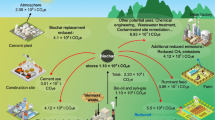Abstract
Increasing atmospheric carbon dioxide (CO2) concentration can affect CO2 level in soil, and this, in turn, may cause changes in soil chemical properties. This study investigated the effect of CO2 exposure on pH and heavy metal mobility in submerged soils. Laboratory-scale batch tests were carried out using two soil samples with different initial pH conditions (A: 5.3; B: 6.3). The changes in the pH values of the soil solutions (i.e., water layer above soil) of the CO2-affected soil samples and controls with time were not significant (p value > 0.05) with the both soil samples, and this may be attributed to the formation of bicarbonate, which may provide a buffering capacity. The effect on heavy metal mobility was different in the soil samples A and B. With the soil sample A, the soil heavy metal concentrations were generally lower in the CO2-affected soil than in the controls. Accordingly, the soil solution heavy metal concentrations were changed. With the soil sample B, the soil heavy metal concentrations of the CO2-affected soil and control did not show a significant difference (p value > 0.05). This can be partially attributed to the dissolution of carbonates that generate bicarbonates, and this is supported by the lower soil Ca concentration in the CO2-affected soil. Overall, the results suggest that the elevated CO2 level in submerged soils may have different effects on the soil chemical properties, and this necessitates continuous research efforts in order to manage and conserve soil environment under conditions of increasing atmospheric CO2 concentration.




Similar content being viewed by others
References
Paustian K, Lehmann J, Ogle S, Reay D, Robertson GP, Smith P (2016) Climate-smart soils. Nature 532:49–57
van Groenigen KJ, Qi X, Osenberg CW, Luo Y, Hungate BA (2014) Faster decomposition under increased atmospheric CO2 limits soil carbon storage. Science 344:508–509
Sleeter BM, Liu J, Daniel C, Rayfield B, Sherba J, Hawbaker TJ, Zhu Z, Selmants PC, Loveland TR (2018) Effects of contemporary land-use and land-cover change on the carbon balance of terrestrial ecosystems in the United States. Environ Res Lett 13:045006
Owusu PA, Asumadu-Sarkodie S (2017) Is there a causal effect between agricultural production and carbon dioxide emissions in Ghana? Environ Eng Res 22:40–54
Shin J, Hong SG, Lee S, Hong S, Lee J (2017) Estimation of soil carbon sequestration and profit analysis on mitigation of CO2-eq. emission in cropland cooperated with compost and biochar. Appl Biol Chem 60:467–472
Brevik CE (2013) The potential impact of climate change on soil properties and processes and corresponding influence on food security. Agric 3:398–417
Janssens IA, Crookshanks M, Taylor G, Ceulemans R (2002) Elevated atmospheric CO2 increases fine root production, respiration, rhizosphere respiration and soil CO2 efflux in Scots pine seedlings. Glob Change Biol 4:871–878
Lee HS, Nam JK, Kim Y, Lee H (2018) Prediction of mycotoxin risks due to climate change in Korea. Appl Biol Chem 61:389–396
Kumeleh AS, Sharmila P, Uprety DC, Saradhi PP (2009) Effects of elevated CO2 on soil physicochemical characteristics under Free Air CO2 Enrichment (FACE) technology. In: IOP conference series: earth and environmental science, vol 6, No. 29. IOP Publishing, UK, p 292045
De Orte MR, Lombardi AT, Sarmiento AM, Basallote MD, Rodriguez-Romero A, Riba I, Del Valls A (2014) Metal mobility and toxicity to microalgae associated with acidification of sediments: CO2 and acid comparison. Mar Environ Res 96:136–144
Millero FJ, Woosley R, Ditrolio B, Waters J (2009) Effect of ocean acidification on the speciation of metals in seawater. Oceanogr 22:72–85
De Orte MR, Sarmiento AM, Basallote MD, RodrÃ−guez-Romero A, Riba I, DelValls A (2014) Effects on the mobility of metals from acidification caused by possible CO2 leakage from sub-seabed geological formations. Sci Total Environ 470–471:356–363
Xiao L, Lian B, Hao J, Liu C, Wang S (2015) Effect of carbonic anhydrase on silicate weathering and carbonate formation at present day CO2 concentrations compared to primordial values. Sci Rep 5:7733
Siirila ER, Navarre-Sitchler AK, Maxwell RM, McCray JE (2012) A quantitative methodology to assess the risks to human health from CO2 leakage into groundwater. Adv Water Resour 36:146–164
Hur JR, Jho EH (2017) Effect of hemoglobin on the growth and Cd accumulation of pea plants (Pisum sativum L.). Appl Biol Chem 60:673–678
KMOE (2009) Official standard methods of soil quality—metal. Korean Ministry of Environment, Korea
Biose E, Amaechi CF, Nnaji GU, Biose O, Erhunmwunse NO (2016) Effects of elevated soil carbon dioxide (CO2) concentrations on spring wheat (Triticum aestivum L.) and soil chemical properties in Sutton Bonington Campus of the University of Nottingham, UK. J Appl Sci Environ Manage 20:293–301
Patil RH, Colls JJ, Steven MD (2010) Effects of CO2 gas as leaks from geological storage sites on agro-ecosystems. Energy 35:4587–4591
Smith KL, Colls JJ, Steven MD (2005) A facility to investigate effects of elevated soil gas concentration on vegetation. Water Air Soil Pollut 161:75–96
Zhao X, Deng H, Wang W, Han F, Li C, Zhang H, Dai Z (2017) Impact of naturally leaking carbon dioxide on soil properties and ecosystems in the Qinghai-Tibet plateau. Sci Rep 7:3001
West JM, Pearce JM, Coombs P, Ford JR, Scheib C, Colls JJ, Smith KL, Steven MD (2009) The impact of controlled injection of CO2 on the soil ecosystem and chemistry of an English lowland pasture. Energy Procedia 1:1863–1870
Gamsjager H, Preis W (1999) Copper content in synthetic copper carbonate. J Chem Educ 76:1339
Lee K-K, Lee SH, Yun S-T, Jeen S-W (2016) Shallow groundwater system monitoring on controlled CO2 release sites: a review on field experimental methods and efforts for CO2 leakage detection. Geosci J 20:569–583
Acknowledgments
This research was supported by National Research Foundation of Korea (NRF-2018R1C1B6002702). This work was also supported by the Hankuk University of Foreign Studies Research Fund (2018).
Author information
Authors and Affiliations
Corresponding author
Rights and permissions
About this article
Cite this article
Jho, E.H., Youn, Y. & Yun, S.H. Effect of CO2 exposure on the mobility of heavy metals in submerged soils. Appl Biol Chem 61, 617–623 (2018). https://doi.org/10.1007/s13765-018-0398-9
Received:
Accepted:
Published:
Issue Date:
DOI: https://doi.org/10.1007/s13765-018-0398-9




